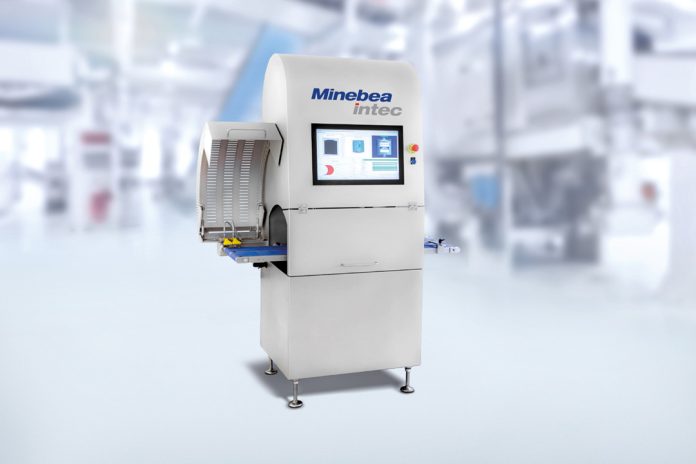Minebea Intec’s hyperspectral technology is a pioneering game changer for the flawless seal seam inspection of coloured packaging
The food industry is in a constant state of flux, driven by technological progress and changing consumer preferences. Manufacturing companies are adapting their marketing activities accordingly. One example of this is the increased use of coloured lidding films on packaging to enhance the appeal and brand identity of products. However, these aesthetic improvements also bring challenges, particularly in the area of quality control. Conventional camera technologies reach their limits when it comes to checking the integrity of seal seam joints under coloured lidding films. This inspection is essential in order to guarantee the calculated best-before date of the food and ensure food quality. This is where the hyperspectral image processing of the VisioPointer® from Minebea Intec, a leading global manufacturer of weighing and inspection technologies, is a pioneering solution.

Image credit: Minebea Intec
The inspection of sealed seams is of central importance in the food industry, as even the slightest contamination or damage can lead to leaking packaging and thus to spoilage of the contents. Unsaleable products and possible recalls can not only be expensive, but also dangerous for the consumer and damaging to the company’s image.
Traditionally, transparent films are used in food packaging to provide a clear view of the seal seam. With the transition to coloured lidding films, monitoring the seal seam becomes considerably more difficult. Conventional camera systems use visible light to capture images, but this light can be absorbed or reflected by the colours of the cover films, resulting in blurred or even invisible images of the seal seam.
A clear view in every respect: How does hyperspectral image processing work?
Hyperspectral image processing offers an innovative solution to this problem. It utilises a broadband halogen light that radiates in a spectrum of wavelengths that go far beyond visible light. This extended wavelength range makes it possible to collect information about the material properties of the objects being analysed, including those that are invisible to the human eye.
In hyperspectral image processing, the object is illuminated with broadband halogen light. The surface of the object interacts in a specific way with the different wavelengths of light. A crucial element in this process is the spectral camera, which analyses the reflected and absorbed light. This camera is able to capture information in hundreds or even thousands of closely consecutive spectral bands. With the VisioPointer® , Minebea Intec offers a visual inspection solution that utilises this technology and is on hand to provide its customers with individual advice throughout the entire project planning process.
Everything from a single source – Minebea Intec supplies turnkey camera inspections
The VisioPointer® offers the widest range of inspection criteria of any single device, supported by three cameras as standard, several types of lighting and optional side and satellite cameras for multi-sided analysis. Added to this is the range of customisation options for integration into packaging lines. “The seal seam inspection with the VisioPointer® is fast, non-destructive and customisable,” says Linus Dellweg. “However, our vision systems can do much more than just this one inspection. Depending on customer requirements, additional parallel inspection steps are possible.” Classic optical inspection processes such as checking the correct placement of a label, reading and evaluating (OCR/V) the date, for example, and the legibility of a barcode or QR code can be easily integrated into the optical inspection and expanded to include additional criteria such as colour, shape or placement of the packaging contents.

Image: Minebea Intec
The vision systems also offer the usual Minebea Intec quality in terms of ease of use: the touchscreen control panel ensures simple operation with an intuitive user interface. In addition to the VisioPointer® Minebea Intec also offers the VisioCompact® and SmartInspector® two more compact visual inspection systems. “We are happy to advise our customers and customise our inspection devices to meet their individual requirements in the best possible way,” says Linus Dellweg. The systems are supplied with infeed and outfeed conveyors, appropriate housing for optimum lighting conditions and a terminal for teaching in the products and monitoring the inspection. An automatic rejector for faulty products is also available. ERP connectivity and cloud-enabled production analysis provide a multi-layered overview of production performance as well as comprehensive analysis and logging options for the data generated.
Quality assurance with visual inspection technologies
Hyperspectral imaging undoubtedly has the potential to take quality assurance and contamination detection in the food industry to a new level. By making invisible information visible, it helps to ensure the safety, freshness and quality of products. At the same time, it makes it possible to meet the ever-increasing aesthetic demands placed on packaging and helps food manufacturers to look to the future with efficiency and a spirit of innovation.
The use of hyperspectral imaging in the food industry offers a number of advantages:
- Detection of contamination: Even the smallest contaminations or irregularities below the coloured seal seam, which would not be visible to the naked eye, can be detected by analysing the spectral data.
- Material recognition: Hyperspectral image processing enables different materials and substances to be distinguished based on their characteristic spectral signatures. This is particularly useful for identifying foreign bodies or unwanted substances.
- Quality control: The technology enables efficient and reliable quality control of packaging and products, which ultimately increases customer satisfaction and trust in the brand.
- Reduction of rejects: Precise detection of defects or contamination can minimise rejects and waste, resulting in cost savings.
- Wide range of possible applications: In addition to the seal seam check, visual inspection also enables classic optical inspection processes such as the correct positioning of a label, reading and evaluation (OCR/V) of the date, for example, as well as the legibility of a barcode or QR code. It can also be used to detect foreign objects.



